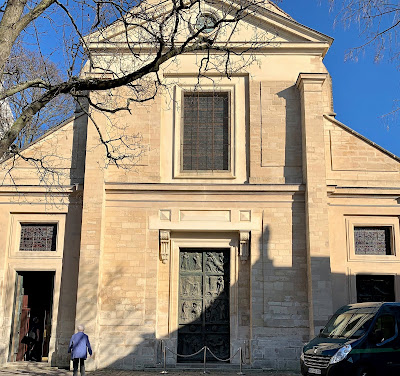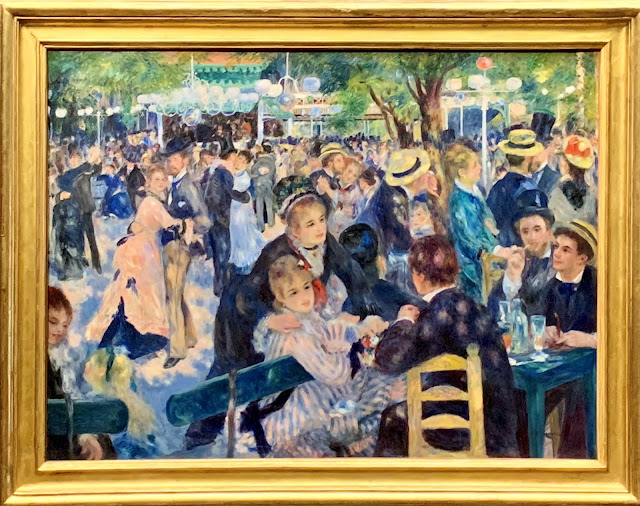One of our favorite Paris neighborhoods for walking tours is Montmartre, a hilltop village in the northern part of Paris. We have taken three different walking tours there, learning something new each time.
First, here is some background about Montmartre during the late 1800's and early 1900's, La Belle Époque. Until 1860, the village was outside the walls of Paris and thus beyond the city limits. As a result, Montmartre had long been free from Parisian taxes and law enforcement. The independent, Bohemian spirit of Montmartre continued after 1860. Everything was available in Monrmartre and it was usually cheaper there. Parisian men would flock there for nighttime entertainment. The Moulin Rouge cabaret was and still is located there. (That place recently celebrated the 130th anniversary of its founding.) Starving artists were able to afford living in Montmartre, which explains why young artists such as Renoir, Utrillo, Picasso and Modigliani congregated there.
Montmarte has a different ambience than the center of Paris. Its looks different, in part, because the rebuilding of Paris in the 1850's-1860's generally did not reach Montmartre. So, buildings are smaller, less uniform and older in appearance. Also, it's a very steep hill whereas Paris is fairly flat.
During our walking tours of Montmartre, we saw all sorts of sights. Here are a few.
Montmartre was once covered with windmills. They were primarily used for grinding gypsum mined from the quarries and tunnels of Montmartre. You've heard of plaster of Paris? Yes, the plaster is made from the gypsum, and Paris is built atop lots of gypsum. Below is one of the two surviving windmills.
If you are looking for an authentic baguette in Montmartre, then the place to go is Coquelicot, considered to be one of the best boulangeries (bakeries) in Paris.

Another well-known place is the Cafe du Deux Moulins (below), where scenes in the film Amelie were filmed. Our guide explained that, because of its fame, the restaurant overcharges for mediocre food. He advised us to eat elsewhere.

We did eat elsewhere, at the affordable and delicious Le Vrai Paris.
One of our guides, Patrick, walked us to Le Bateau Lavoir, the location where various artists once lived and painted, including Picasso, Modigliani, Braque and Gris, to name a few.
Around the corner, Patrick pointed some the ateliers (studios) used by artists over time. The skylights are ideal for natural lighting.
We also learned about Wallace Fountains (one is pictured below). During the Franco-Prussian War of 1870 and the Paris Commune of 1871, water became scarce and pricey. It was cheaper to drink wine and beer. A wealthy Englishman living in Paris decided that free water for all was needed. He financed the installation of elegant drinking fountains all over Paris. Many are still in place after more than 140 years, including the two pictured below.
 |
| Montmartre |
 |
| Saint-Sulpice |
Our tour included a stop at the home of Dalida, the beloved French singer and actress. Despite her success, she had a tragic life. People close to her died by suicide and she ended her life at age 54.
The other surviving windmill of Montmartre is pictured below. It sits atop the restaurant called La Moulin de la Galette, made famous by Auguste Renoir's painting. The 1876 painting, Bal du moulin de la Galette, depicts a dance in the garden of the restaurant.
Another stop on the tour was an ancient church on top of the hill, the Église Saint-Pierre de Montmartre. The church, completed in 1147, was part of an abbey and was built over an ancient Roman temple, the Temple of Mars, from which the area takes its name.
 |
| Église Saint-Pierre de Montmartre |
 |
| The church's bronze doors date are of recent vintage. The doors by Italian sculptor Tommaso Gismondi depict scenes from the lives the church's three patron saints, Saint Denis, Saint Peter and Mary. |
A highlight of the walking tour is visiting La basilique du Sacré-Cœur de Montmartre, also located at the summit of the hill. Sacré-Cœur was built over a former gypsum quarry. The location is also believed to be the place where Saint Denis was martyred in the 3rd century.
Sacré-Cœur was built during 1875-1923, following the Franco-Prussian and Paris Commune. The church was built as national penance for France's defeat in the war and the atrocities relating to the Commune.
The architectural style is unique. One way to describe it is Romano-Byzantine. There are other less flattering descriptions.

 |
| A view of the mosaic Christ in Majesty by Luc-Olivier Merson |

The best part of the walking tour was the ending location. From the top of Montmartre, the view of the Paris skyline is wonderful.
Thanks for visiting Montmartre with us.














No comments:
Post a Comment